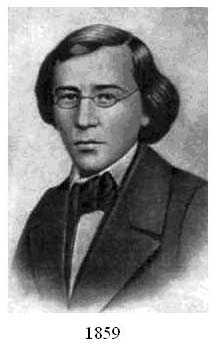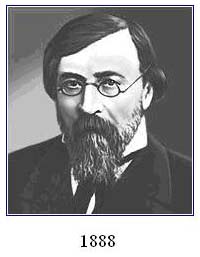Difference between revisions of "Nikolaj Gavrilovič Černyševskij"
WikiLingua (talk | contribs) |
m (+cats) |
||
| Line 18: | Line 18: | ||
It would take some decades more, until Boris V. Tomaševskij (1919/23) would pick up the problem and discuss it critically from a methodological point of view. Anyway, N.G. Černyševskij can be credited for having pointed out that the problem of poetic language is not an isolated one, but should be studied in comparison to prosaic language, and for having done a first step towards an empirical, quantitative study of this problem. | It would take some decades more, until Boris V. Tomaševskij (1919/23) would pick up the problem and discuss it critically from a methodological point of view. Anyway, N.G. Černyševskij can be credited for having pointed out that the problem of poetic language is not an isolated one, but should be studied in comparison to prosaic language, and for having done a first step towards an empirical, quantitative study of this problem. | ||
| + | |||
| + | [[Category:En]] | ||
| + | [[Category:BIOG]] | ||
Revision as of 20:03, 6 July 2007
Nikolaj Gavrilovič Černyševskij (1828-1889) is one of the best known Russian journalists, writers, and literary critics of the 19th century. He is also known for his philosophical and economical writings, with which he became one of the most important theoreticians of radical social democracy. He is less known, however, for having introduced quantitative arguments to the study of poetic language. Although the relevant passages are rather scarce, they deserve mentioning, since ultimately, they make Černyševskij a forerunner of quantitative stylistics.
Life
Being the son of a Russian priest from Saratov, Černyševskij was a typical representative of the so-called raznočincy, a member of the young generation from the middle class who, in the Tsarist Russia of the mid-nineteenth century, started fighting for social rights and democracy. From 1842 to 1846, Černyševskij was educated in the local priest seminar, before he went to St. Petersburg to enter the historical-philological faculty of St. Petersburg University. In 1846, he passed the entrance exams in mathematics, physics, logic, and literature, as well as in Latin and French, and he was accepted a student.
Having finished his university career, Černyševskij returned to Saratov and became a senior teacher at the secondary school of his home town. In 1853, after his marriage, he decided to go back to Petersburg, where he started a journalistic career. In the very same year, Černyševskij began to cooperate with two important journals of that time, the Sovremennik (N.A. Nekrasov), on the one hand, and the Otečestvennye Zapiski (A.A. Kraevskij), on the other. Černyševskij soon concentrated on the Sovremennik only, from 1854 being responsible for the criticism and bibliography sections. In 1856, he handed the criticism section to N.A. Dobroljubov, himself concentrating on politics, philosophy, and economy. He was a fervent defender of a materialist aesthetic theory, best expressed in his M.A. Thesis "Esthetic Relations of Art to Reality".
His successful defence of this thesis in 1855 caused public uproar, and it was accepted by the ministry only three years later. By and by, Černyševskij – who was much influenced by social utopians like Saint Simon, Fourier, and Feuerbach – became somewhat like a leader of radical and social parts of society; as a consequence, he soon attracted the attention of Secret Police. In 1862, Sovremmenik was closed for eight months, Černyševskij was arrested and imprisoned in the Fortress of Sts. Peter and Paul. During imprisonment, he wrote his famous novel Što delat’ [What is to be Done], which was allowed to be published by mistake in 1863. Černyševskij was finally sentenced in 1864, deprived of all rights, and sent to Siberia. He was allowed to return to the European part of Russia only in 1883. In 1889, he came back to his home town Saratov, where he died the same year.
Contribution
As to the introduction of quantitative arguments to literary criticism, one can say that Černyševskij indeed was the first to bring up the question as to the relation of stressed and unstressed syllables in poetry and prose. The question was raised by Černyševskij (1855) in the journal Sovremennik, when he discussed P.V. Annenkov’s (1812-87) edition of A.S. Puškin’s Collected Works. In his critique, Černyševskij was struck by the observation that the vast majority of poems were characterized by a binary meter: 179 poems written in iambs (xξ), followed by 29 poems in trochees (ξ). Only very few poems included ternary meters, i.e. 7 poems with amphibrachs (xξx), 6 with dactyls (ξxx), and only one with anapests (xxξ). Given the clear dominance of binary meter, Černyševskij (1855: 286) raised the question if the iamb might be “the most natural meter for the Russian language”. As a first indication that this might not be the case, Černyševskij objected that in Russian, as compared to German, words rather tend to be multi-syllabic, that prepositions and pronouns usually do not have any stress, and that all other words have one stress only. Černyševskij (1855: 287) then submitted this hypothesis to an empirical test: Counting stressed and unstressed syllables in three randomly chosen prose passages by A.F. Pisemskij (1821-1881), Černyševskij obtained a relations of 66 stressed vs. 193 unstressed syllables:
In two other passages, he found similar relations of 25 vs. 75, and 27 vs. 83. Although these passages are rather short, in all three cases (as well as in the combination of them) the relation of stressed and unstressed syllables displays an “astonishing closeness to each other”, which is characterized by an almost constant proportion of 1:3. This caused Černyševskij (1855: 287) to “draw the inevitable conclusion that, in Russian, iambs and trochees, which demand 15 stresses within 30 syllables, are by far not as natural a dactyls, amphibrachs, or anapests, which demand 10 stresses within 30 syllables.
Černyševskij’s innovative approach remained forgotten for a long time. Almost 20 years later, Dmitrij A. Averkiev (1836-1905), a well-known writer, literary critic and journalist, referred to Černyševskij’s ideas in his own ruminations On Drama (first published in the journal Russkij vestnik in 1877/78, later edited in book form in 1893 and 1907). Averkiev had graduated from the department of natural sciences of the physical-mathematical faculty (St. Petersburg University) in 1859, where he had close contact with important persons from the literary scene, such as Apollon A. Grigor’ev (1822-64) or Nikolaj N. Strachov (1828-96) who, curiously enough, also had studied and taught mathematics in St. Petersburg. In his ruminations on dramatic language, Averkiev harshly criticized the fundamentals of Černyševskij’s approach. According to him, “clean iambs or trochees are a rarity in Russian: “In iambs or trochees with four ictuses, four stresses are a great exception; rather, there are two or three of them, and in iambs with five ictuses, three or four. Thus, there are two or three stresses within 8 or 9 syllables, three or four within 10 or 11 syllables, and four or five within 12 or 13 syllables.” With reference to Černyševskij’s analysis, Averkiev thus concluded that in all cases, these are “just as many as the author of that unfortunate article obtained as a result of his study on Russian prose”.
It would take some decades more, until Boris V. Tomaševskij (1919/23) would pick up the problem and discuss it critically from a methodological point of view. Anyway, N.G. Černyševskij can be credited for having pointed out that the problem of poetic language is not an isolated one, but should be studied in comparison to prosaic language, and for having done a first step towards an empirical, quantitative study of this problem.


